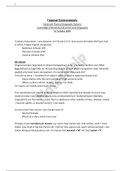Study guide
(CIEGeography9696) Tropical Environments Notes
- Institution
- CIE
This document contains revision notes for the "Tropical Environments" topic from section "Advanced Physical Geography Options." (Cambridge International AS and A level Geography) (These notes are suitable for CIE Geography A2 Level physical paper this June) Syllabus 9696
[Show more]




